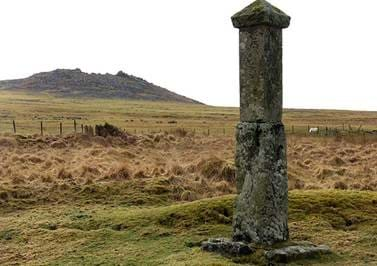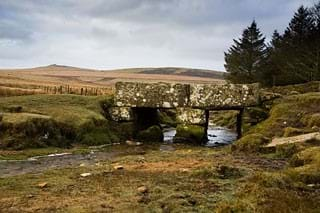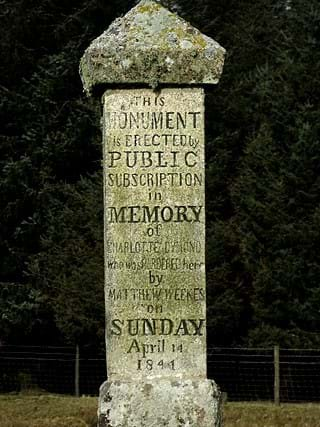It has all the ingredients of a classic tragedy; a brutal murder in a desolate location, a pretty young victim and a spurned lover who was hanged despite claims of his innocence. The murder took place on Sunday the 14th April 1844 and it is said that the ghost of Charlotte Dymond roams the moor on this date wearing the Sunday best clothes she was killed in.

The Memorial Nr Roughtor marks the scene of the murder
Charlotte Dymond was a domestic servant working on a farm on the edge of Bodmin Moor, between Camelford and Davidstow, when she was 18 years old. Penhale farm was owned by an elderly widow and her son, and along with Charlotte there were two other live-in servants, John Stevens and Matthew Weeks, both aged in their early 20s.
At some point Charlotte and Matthew had become boyfriend and girlfriend. It is said Charlotte was a pretty girl with a flirtatious nature, whereas Matthew was described as not at all good-looking. Short, missing many teeth and with a heavy limp most people would not have put the two together. It is said that he liked to dress well though.
One possible reason for this unlikely couple could have been the combination of Matthew having come into a modest inheritance and Charlotte being illegitimate with no family.
Charlotte, however, had another suitor; Thomas Prout. The 26 year old was the nephew of Penhale Farm's owner and was a labourer who had worked with Matthew Weeks on occasion. It is said the two got on, but it appears Prout had intentions towards Charlotte. Another servant, John Stevens, had overheard Prout stating he could take Charlotte away from Weeks and at a later time, it was revealed that the two may have been planning to elope.
The day of Charlotte's death was a Sunday and the entire household would have had on their ‘Sunday Best’ outfits. Charlotte wore a green striped dress and a red shawl. The last time she was seen alive was soon after her and Weeks had left the farm together, heading towards the moor. The couple were spotted by an elderly farmer through the fog, he recognised Weeks from his pronounced limp.
Later that evening Weeks returned to the farm alone, although it appears that was not unusual. As the days went by and Charlotte still did not return, people began to notice things. Weeks's shirt was torn and his trousers were muddied, although he claimed he had not been on the moor. In response to the growing suspicion Weeks told the household that Charlotte had been offered a position in Blisland, some miles away and had set off with the intention of staying at an acquaintance's house on the way.
A week after Charlotte's disappearance the household decided action was needed and John Stevens and the farmer set off to check on Week's story. It was found that no position had been offered in Blisland and that Charlotte had not stayed at the acquaintance's house. On the same day Matthew Weeks put on his Sunday best and left Penhale farm with no intention to return.
The following day, the farmer's wife took Weeks' clothes to be washed. It was then that she noticed the torn collar, missing buttons and also some spots of blood on the shirt. The suspicion that Weeks had murdered Charlotte seemed beyond doubt now.

Roughtor Ford where the body was found
On the Tuesday, over a week after Charlotte had last been seen, a search party found her body on the banks of the river Alan in the shadow of Roughtor, Cornwall's second highest point. She had been killed by an extremely deep cut to her throat from ear to ear. Later examination suggested it was probably caused by two cuts.
With a body being found and the amount of circumstantial evidence linking Matthew Weeks to the murder a warrant was issued for his arrest but first he needed to be found. He was found in Plymouth, at his sister's house; apparently he had been planning to flee to the Channel Islands. Upon searching Weeks, a pair of ladies' gloves and a blood-spotted lady's handkerchief were found.
The murder of Charlotte Dymond had shocked the local community and they demanded justice. Weeks was tried at Bodmin Assize Court on August 2nd. Bodmin was the county town in those days and this reflected the attention the case had received. In addition to further circumstantial evidence the coroner made it clear that he believed the wound that killed Charlotte could not have been self inflicted.
Weeks had pleaded not guilty, but it took the jury little over half an hour to return a guilty verdict. The sentence was death by hanging.
In the ten days Matthew Weeks spent in Bodmin Gaol awaiting execution two letters were attributed to him. Being illiterate these were dictated. The first was to his family and the second a confession. It is this confession that has probably provided more weight to the argument of Weeks' innocence than anything else. It was written in a style far more eloquent than one would have expected from the mouth of an uneducated farm labourer:
"I hope young men will take a warning by me and not put too much confidence in young women, the same as I did; and I hope young females will take the same by young men. I loved that girl as dear as I loved my life; and after all the kind treatment I have showed her, and then she said she would have nothing more to do with me. And after this was done, then bitterly I did lament, thinking what would be my end. And I thank the judge and jury too, for they have given me no more than was my due."
At 12.00 noon on 12th August 1844 Matthew Weeks was hung in front of a crowd of several thousand outside Bodmin Gaol. His body was buried in the prison's coal yard.

The Charlotte Dymond Memorial
From the above short account of the events surrounding this tragedy the case would seem fairly clear cut. However, people love a mystery the story of a spurned lover and murder at such a bleak, desolate spot lends itself to this.
One explanation of the events put forward is it was suicide; Charlotte had believed herself to be pregnant and to avoid the shame she had cut her own throat. This seems fanciful given there appeared to be two suitors willing to marry her and the extreme force used to inflict the wound. Along with this are suggestions the three eyewitnesses were unreliable and the confession was obviously fabricated. With no other obvious suspects and so much circumstantial evidence even in the absence of witnesses and a confession the weight of evidence seems to be compelling.
It seems there is little mystery to the tragic death of Charlotte Dymond and it is just another sad example of the age old crime of passion. The local community were in little doubt of Weeks' guilt and a memorial was erected on the spot of crime and reads:
"This monument is erected by public subscription in memory of Charlotte Dymond who was murdered here by Matthew Weeks on Sunday April 14 1844
